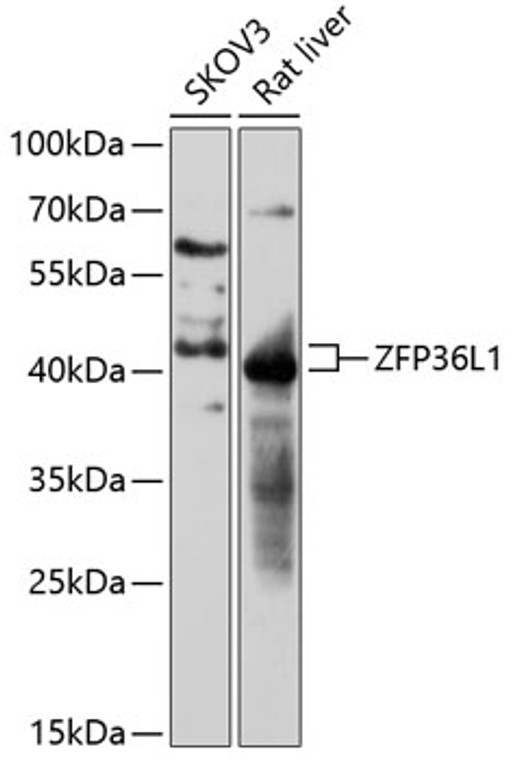| Host: |
Rabbit |
| Applications: |
WB |
| Reactivity: |
Human/Mouse/Rat |
| Note: |
STRICTLY FOR FURTHER SCIENTIFIC RESEARCH USE ONLY (RUO). MUST NOT TO BE USED IN DIAGNOSTIC OR THERAPEUTIC APPLICATIONS. |
| Short Description: |
Rabbit polyclonal antibody anti-ZFP36L1 (1-338) is suitable for use in Western Blot research applications. |
| Clonality: |
Polyclonal |
| Conjugation: |
Unconjugated |
| Isotype: |
IgG |
| Formulation: |
PBS with 0.01% Thimerosal, 50% Glycerol, pH7.3. |
| Purification: |
Affinity purification |
| Dilution Range: |
WB 1:500-1:2000 |
| Storage Instruction: |
Store at-20°C for up to 1 year from the date of receipt, and avoid repeat freeze-thaw cycles. |
| Gene Symbol: |
ZFP36L1 |
| Gene ID: |
677 |
| Uniprot ID: |
TISB_HUMAN |
| Immunogen Region: |
1-338 |
| Immunogen: |
Recombinant fusion protein containing a sequence corresponding to amino acids 1-338 of human ZFP36L1 (NP_004917.2). |
| Immunogen Sequence: |
MTTTLVSATIFDLSEVLCKG NKMLNYSAPSAGGCLLDRKA VGTPAGGGFPRRHSVTLPSS KFHQNQLLSSLKGEPAPALS SRDSRFRDRSFSEGGERLLP TQKQPGGGQVNSSRYKTELC RPFEENGACKYGDKCQFAHG IHELRSLTRHPKYKTELCRT FHTIGFCPYGPRCHFIHNAE ERRALAGARDLSADRPRLQH SFSFAGFPSAAATAAATGLL DSPTSITPPPILSADDLLG |
| Tissue Specificity | Expressed mainly in the basal epidermal layer, weakly in the suprabasal epidermal layers. Expressed in epidermal keratinocytes (at protein level). Expressed in osteoblasts. |
| Post Translational Modifications | Phosphorylated. Phosphorylated by RPS6KA1 at Ser-334 upon phorbol 12-myristate 13-acetate (PMA) treatment.this phosphorylation results in dissociation of the CCR4-NOT deadenylase complex and induces p38 MAPK-mediated stabilization of the low-density lipoprotein receptor LDLR mRNA. Phosphorylated by protein kinase AKT1 at Ser-92 and Ser-203 in response to insulin.these phosphorylations stabilize ZFP36L1, increase the association with 14-3-3 proteins and mediate ARE-containing mRNA stabilization. AKT1-mediated phosphorylation at Ser-92 does not impair ARE-containing RNA-binding. Phosphorylated at Ser-54, Ser-92 and Ser-203 by MAPKAPK2.these phosphorylations increase the association with 14-3-3 proteins and mediate ARE-containing mRNA stabilization in a protein kinase AKT1-independent manner. MAPKAPK2-mediated phosphorylations at Ser-54, Ser-92 and Ser-203 do not impair ARE-containing RNA-binding. Phosphorylations increase the association with 14-3-3 proteins and mediate ARE-containing mRNA stabilization during early adipogenesis in a p38 MAPK- and AKT-dependent manner. Ubiquitinated. Ubiquitination leads to proteasomal degradation, a process inhibited by phosphorylations at Ser-90, Ser-92 and Ser-203. |
| Function | Zinc-finger RNA-binding protein that destabilizes several cytoplasmic AU-rich element (ARE)-containing mRNA transcripts by promoting their poly(A) tail removal or deadenylation, and hence provide a mechanism for attenuating protein synthesis. Acts as a 3'-untranslated region (UTR) ARE mRNA-binding adapter protein to communicate signaling events to the mRNA decay machinery. Functions by recruiting the CCR4-NOT deadenylase complex and components of the cytoplasmic RNA decay machinery to the bound ARE-containing mRNAs, and hence promotes ARE-mediated mRNA deadenylation and decay processes. Induces also the degradation of ARE-containing mRNAs even in absence of poly(A) tail. Binds to 3'-UTR ARE of numerous mRNAs. Positively regulates early adipogenesis by promoting ARE-mediated mRNA decay of immediate early genes (IEGs). Promotes ARE-mediated mRNA decay of mineralocorticoid receptor NR3C2 mRNA in response to hypertonic stress. Negatively regulates hematopoietic/erythroid cell differentiation by promoting ARE-mediated mRNA decay of the transcription factor STAT5B mRNA. Positively regulates monocyte/macrophage cell differentiation by promoting ARE-mediated mRNA decay of the cyclin-dependent kinase CDK6 mRNA. Promotes degradation of ARE-containing pluripotency-associated mRNAs in embryonic stem cells (ESCs), such as NANOG, through a fibroblast growth factor (FGF)-induced MAPK-dependent signaling pathway, and hence attenuates ESC self-renewal and positively regulates mesendoderm differentiation. May play a role in mediating pro-apoptotic effects in malignant B-cells by promoting ARE-mediated mRNA decay of BCL2 mRNA. In association with ZFP36L2 maintains quiescence on developing B lymphocytes by promoting ARE-mediated decay of several mRNAs encoding cell cycle regulators that help B cells progress through the cell cycle, and hence ensuring accurate variable-diversity-joining (VDJ) recombination and functional immune cell formation. Together with ZFP36L2 is also necessary for thymocyte development and prevention of T-cell acute lymphoblastic leukemia (T-ALL) transformation by promoting ARE-mediated mRNA decay of the oncogenic transcription factor NOTCH1 mRNA. Participates in the delivery of target ARE-mRNAs to processing bodies (PBs). In addition to its cytosolic mRNA-decay function, plays a role in the regulation of nuclear mRNA 3'-end processing.modulates mRNA 3'-end maturation efficiency of the DLL4 mRNA through binding with an ARE embedded in a weak noncanonical polyadenylation (poly(A)) signal in endothelial cells. Also involved in the regulation of stress granule (SG) and P-body (PB) formation and fusion. Plays a role in vasculogenesis and endocardial development. Plays a role in the regulation of keratinocyte proliferation, differentiation and apoptosis. Plays a role in myoblast cell differentiation. |
| Protein Name | Mrna Decay Activator Protein Zfp36l1Butyrate Response Factor 1Egf-Response Factor 1Erf-1Tpa-Induced Sequence 11bZinc Finger Protein 36 - C3h1 Type-Like 1Zfp36-Like 1 |
| Database Links | Reactome: R-HSA-450385 |
| Cellular Localisation | NucleusCytoplasmCytoplasmic GranuleP-BodyShuttles Between The Nucleus And The Cytoplasm In A Xpo1/Crm1-Dependent MannerComponent Of Cytoplasmic Stress GranulesLocalizes In Processing Bodies (Pbs) |
| Alternative Antibody Names | Anti-Mrna Decay Activator Protein Zfp36l1 antibodyAnti-Butyrate Response Factor 1 antibodyAnti-Egf-Response Factor 1 antibodyAnti-Erf-1 antibodyAnti-Tpa-Induced Sequence 11b antibodyAnti-Zinc Finger Protein 36 - C3h1 Type-Like 1 antibodyAnti-Zfp36-Like 1 antibodyAnti-ZFP36L1 antibodyAnti-BERG36 antibodyAnti-BRF1 antibodyAnti-ERF1 antibodyAnti-RNF162B antibodyAnti-TIS11B antibody |
Information sourced from Uniprot.org
12 months for antibodies. 6 months for ELISA Kits. Please see website T&Cs for further guidance








